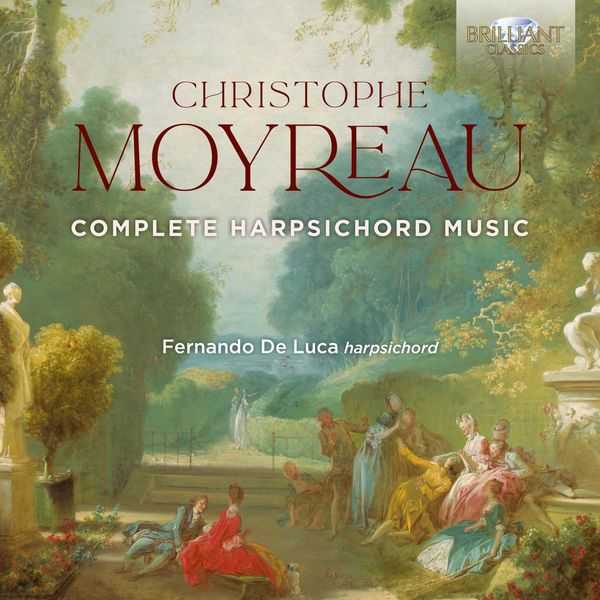

Composer: Christophe Moyreau
Performer: Fernando De Luca
Number of Discs: 7
Format: FLAC (tracks)
Label: Brilliant Classics
Catalogue: 96285
Release: 2022
Size: 5.74 GB
Recovery: +3%
Scan: cover
Pièces de clavecin, Op. 1, suite in D Minor
01. I. Ouverture
02. II. Allemande
03. III. Gigue
04. IV. Menuet I-II
05. V. La fausse musette
06. VI. La petitte Françoise
07. VII. L’iroquoise
08. VIII. La petitte Follette
09. IX. La mignone
10. X. La guepine, rondeau
11. XI. L’Orléanois, rondeau
12. XII. La japonoisse
13. XIII. La chinoises
14. XIV. Les cyclopes forgeants le foudre meurtrier d’esculape – Apollon vient les exterminer
15. XV. Concert des sicilliens delivrez du bruit des cyclopes
Pièces de clavecin, Op. 1, suite in D Major
16. I. Ouverture
Pièces de clavecin, Op. 1, concerto
17. I. Allegro
18. II. Grave
19. III. Allegro assai
Pièces de clavecin, Op. 1, suite in F Minor and F Major
20. I. Ouverture
21. II. Allemande
22. III. Gigue
23. IV. Menuet I-II-III
24. V. La sensible, rondeau
25. VI. La galanterie, rondeau
26. VII. L’Espion
27. VIII. La dupe, 2de partie
28. IX. Le filou, 3e partie
29. X. La doucereusse
30. XI. La jalouse
31. XII. L’animée
Pièces de clavecin, Op. 1, suite in F Major
32. I. Ouverture
Pièces de clavecin, Op. 1, sonata
33. I. Adagio
34. II. Allegro
35. III. Largo
36. IV. Allegro assai
Pièces de clavecin, Op. 2, suite in A Major and A Minor
37. I. Ouverture
38. II. Allemande
39. III. Courante
40. IV. Gigue
41. V. Menuet 1er – 2e Partie
42. VI. La Marianne
43. VII. Les epineusse, rondeau
44. VIII. La Canadienne, marche
45. IX. La jeunette
46. X. L’Enbarassante, rondeau
47. XI. La plaisante
48. XII. L’Agissante
49. XIII. La bourruë
50. XIV. La Preludante
51. XV. L’Italienne
52. XVI. Le tour Italien
53. XVII. L’Interompuë
Pièces de clavecin, Op. 2, suite in A Minor
54. I. Ouverture
Pièces de clavecin, Op. 2, sonate
55. I. Adagio
56. II. Allegro
57. III. Grave
58. IV. Presto
Pièces de clavecin, Op. 3, suite in C/C Minor
59. I. Ouverture
60. II. Allemande
61. III. Courante
62. IV. Gigue
63. V. Menuet I-II
64. VI. Les nones
65. VII. Preparation du voyage de donery
66. VIII. Marche
67. IX. La tristesse
68. X. Le retour
69. XI. La joie marquée par la danse (Menuets I-II-III)
70. XII. Le gaigne-pain des voyageurs, tambourins
71. XIII. La flotante, rondeau
72. XIV. Le baccante
73. XV. Le jaloux, rondeau
74. XVI. La coquette
75. XVII. Le preludant
76. XVIII. L’Euridice
77. XIX. La comique
78. XX. L’Orphée
79. XXI. Le caprice
80. Ouverture in C Minor
Pièces de clavecin, Op. 4, suite in G Minor/G
81. I. Ouverture
82. II. Allemande
83. III. Courante
84. IV. Seconde courante
85. V. Sarabande
86. VI. Gigue
87. VII. Le nouveau, rigaudon
88. VIII. La mode, menuet
89. IX. L’Insensé
90. X. La discorde
91. XI. L’Étourdi, I-II partie
92. XII. Le pegase, rondeau I-II
93. XIII. L’Holandoise
94. XIV. Les papillons
95. XV. La momus, rondeau
96. XVI. La loire
97. Ouverture in G Major
Pièces de clavecin, Op. 4, sonate in G Major
98. I. Adagio
99. II. Allegro
100. III. Adagio
101. IV. Allegro assai
Pièces de clavecin, Op. 5, suite in E Minor/E Major
102. I. Ouverture en mi mineur
103. II. Allemande
104. III. Courante
105. IV. Sarabande
106. V. Gigua
107. VI. Rigaudon
108. VII. Le Fagotto
109. VIII. Seconde rigaudon
110. IX. Menuet
111. X. Seconde menuet
112. XI. Troisieme menuet
113. XII. La petitte riante
114. XIII. La parissienne, partie I-II
115. XIV. Le croustilleux
116. XV. Le pandoure, rondeau
117. XVI. Le prussien, rondeau
118. XVII. L’azem-beba carmagniole
119. XVIII. Euphrosine
120. XIX. Talië
121. XX. Aglaeé
122. XXI. Ballet des graces. Menuet I-II-III
123. XXII. L’Organisée
124. XXIII. Les cloches d’Orléans, pièce pour l’orgue et le clavecin
Sinfonia No. 1 in B Minor
125. I. Vivace
126. II. Andante
127. III. Tempo di minuetto
Sinfonia No. 2 in B-Flat Major
128. I. Vivace
129. II. Largo
130. III. Minuetto
Sinfonia No. 3 in E Major
131. I. Vivace
132. II. Adagio
133. III. Minuetto
Sinfonia No. 4 in E-Flat Major
134. I. Allegro
135. II. Adagio
136. III. Tempo di minuetto, gratioso
Sinfonia No. 5 in F-Sharp Minor
137. I. Allegro molto
138. II. Largo
139. III. Tempo di minuetto, Vivace
Sinfonia No. 6 in F Minor
140. I. Vivace
141. II. Largo
142. III. Tempo di minuetto
143. Appendix from, Op. 5: I. Ouverture en E
Concerto in E Minor
144. I. Allegro
145. II. Adagio
146. III. Allegro
Sonate in E Minor
147. I. Allegro
148. II. Adagio-Vivace
From, Op. 3, concerto in C Major
149. I. Allegro
150. II. Adagio
151. III. Allegro
From, Op. 2, le purgatoire in A Minor
152. I. Plaintes de morts – Cris lamantables – Redoublemens de cris – Sommeil – Reveil – Douleurs amere – Souffrances aigue – Accablement – Sommeil eternal
The first-ever survey on record of the complete surviving output by a significant contemporary of Rameau: a missing piece in the jigsaw of the French Baroque.
Christophe Moyreau (1700-1774) was born and died in the city of Orleans, and perhaps one reason why he never attained the fame of contemporaries such as Couperin and Rameau was that he never occupied posts in the French capital. Too much of his career is still shrouded in mystery, but he listed his occupation as “organist” in the marriage register of his home church in 1726 – becoming father to 11 children over the next 18 years – and at some point he became titular organist at the important Church of Saint-Aignan before taking up the post as organist of the cathedral in 1737.
It seems to have been the lengthy restoration of the cathedral’s organ which prompted Moyreau in 1753 to gather together much of his previously composed music into six books of Pièces de clavecin. He published them in two volumes during a lengthy period of what would otherwise have been enforced inactivity; he also wrote and issued a small but influential teaching manual in the same year.
The 126 separate pieces in the six books are remarkably varied in style but consistent in quality of invention. There are dances and character-pieces, organised into long suites, but also standalone overtures, sonatas and a solo concerto. The last of the suites concludes with a grand evocation of the bells of Orleans which has become his best-known work.
The second volume includes six “simphonies” for harpsichord, also recorded here by Fernando de Luca, making this set by far the most comprehensive collection of Moyreau’s music ever released.



